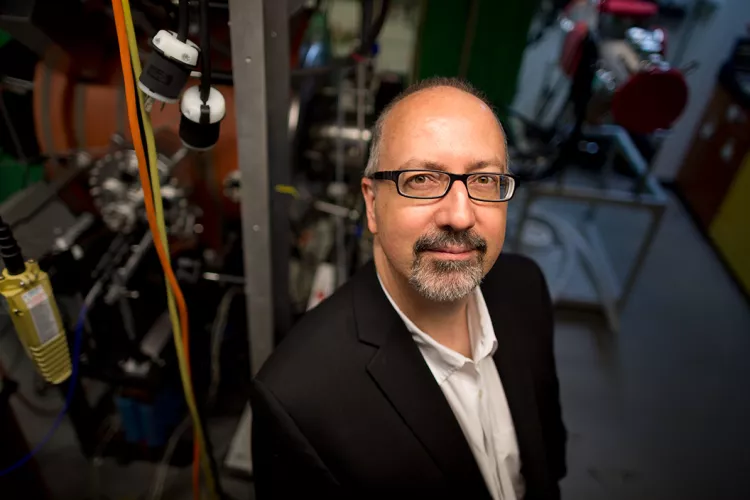Physicist Mike Brown Awarded Department of Energy Grant to Support Fusion Energy Research

"The Swarthmore Spheromak Experiment (SSX) Lab is one of the few places in the U.S. where undergraduate physicists have access to astrophysically-relevant laboratory plasma," says Morris L. Clothier Professor of Physics Michael Brown.
Michael Brown, the Morris L. Clothier Professor of Physics and Interim Department Chair, has been awarded a grant by the Department of Energy’s INFUSE program that will help bring fusion energy to the marketplace in the U.S. INFUSE is sponsored by the Office of Fusion Energy Sciences (FES) within DOE’s Office of Science.
The focus to accelerate research to develop innovative fusion energy in the private sector is key — and exciting, says Brown.
“Fusion energy research has been supported by the U.S. Department of Energy for over 50 years, and a great deal has been learned,” says Brown. “A few mainstream ideas have emerged, and many others had to be discarded. Building a large mainstream fusion facility now costs $10 billion. In the past decade, billionaire investors have noticed that for less than $1 billion, they can invest in non-mainstream, previously discarded fusion schemes that might bear fruit.”
The INFUSE program’s aim is accelerating the development of fusion energy in the private sector. The grant creates valuable experiences for Swarthmore students to be part of including real-world experience. “Companies have to meet milestones or the investors pull their funding,” he says.
“Most of our physics students will end up in companies rather than an academic environment. For this grant, three Swarthmore students will be part of a team working for the company HelicitySpace. They will build a diagnostic that we are expected to deliver this summer,” says Brown. HelicitySpace describes its work as developing “critical propulsion and power technology necessary for enabling humanity's expansion into the solar system.”
Notably, companies and their investors work on a much different time scale than science-based Federal agencies like DOE or NSF, says Brown. Through his work with the Swarthmore Spheromak Experiment (SSX) machine he designed and created over 20 years ago, Brown has provided the chance for students to participate in pioneering research.
“The SSX lab is one of the few places in the U.S. where undergraduate physicists have access to astrophysically-relevant laboratory plasma," says Brown.
The work sustained by this recent grant is a new foray for Brown into research for a non-government entity.
“Many fusion schemes were discarded in the 1990’s due to budget constraints, and the emergence and success of mainstream schemes like the tokamak,” says Brown. “In the intervening 30 years, there have been technological advances like superconducting magnets, high power microwave heating sources, and computer power. The HelicitySpace scheme happens to align with what we’ve been studying at SSX.”
Another scheme called a “magnetic mirror” has been resurrected by another group in Wisconsin, he says.
The $80,000 grant provided by the Department of Energy’s INFUSE program designed to set up partnerships with companies and spent by non-government organizations like Swarthmore College. “I would be excited to be part of a discovery of an alternate scheme for fusion energy,” says Brown.
“Our students are fortunate to have access to such a high-quality research experience under Mike’s mentorship and I enjoy reading every year about the growing number of students who have come through the SSX lab,” says Tania Johnson, the College’s director of sponsored programs who has provided research administration support for Dr. Brown’s research program for nearly 18 years.
“For context, Swarthmore is one of only two small liberal arts colleges that currently has an active prime grant from the Department of Energy and is typically the only grantee in the county,” Johnson says. “This INFUSE-funded partnership with HelicitySpace is an example of the ‘Triple Helix model of innovation’ that brings together expertise from the government, higher education institutions, and industry.”



